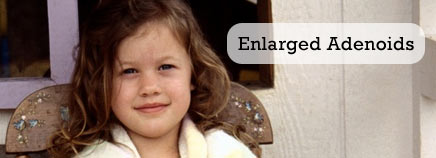
Enlarged Adenoids
Adenoids are a patch of tissue that sits at the very back of the nasal passage. Like tonsils, adenoids help keep the body healthy by trapping harmful bacteria and viruses that you breathe in or swallow. Although you can see the tonsils at the back of the throat, adenoids aren’t directly visible.
Adenoids do important work as infection fighters for babies and young children. But they become less important once a child gets older and the body develops other ways to fight germs. In kids, adenoids usually begin to shrink after about 5 years of age and often practically disappear by the teen years.
Because adenoids trap germs that enter the body, adenoid tissue sometimes temporarily swells (becomes enlarged) as it tries to fight off an infection. The swelling sometimes gets better, but sometimes adenoids can get infected. If the adenoids get infected a lot, a doctor might recommend they be removed. Often, tonsils and adenoids are surgically removed at the same time.
Symptoms of Enlarged Adenoids
These symptoms are often associated with enlarged adenoids:
- difficulty breathing through the nose
- breathing through the mouth
- talking as if the nostrils are pinched
- noisy breathing
- snoring
- stopped breathing for a few seconds during sleep (obstructive sleep apnea)
- frequent “sinus” symptoms
- ongoing middle ear infections or middle ear fluid in a school-aged child
If enlarged adenoids are suspected, the doctor may ask about and then check your child’s ears, nose, and throat, and feel the neck along the jaw. To get a really close look, the doctor might order X-rays or look into the nasal passage with a tiny telescope. For a suspected infection, the doctor may prescribe different types of medicine like pills or liquids. Nasal steroids (a liquid that is sprayed into the nose) might also be prescribed to help reduce swelling in the adenoids.
When Is Surgery Necessary?
If enlarged or infected adenoids keep bothering your child and are not controlled by medication, the doctor may recommend surgically removing them with an adenoidectomy. This may be recommended if your child has one or more of the following:
- difficulty breathing
- obstructive sleep apnea
- repeated infections
- frequent sinus infections
- ear infections, middle ear fluid, and hearing loss requiring a second or third set of ear tubes
Having your child’s adenoids removed is especially important if repeated infections lead to sinus and ear infections. Badly swollen adenoids can interfere with the ability of the middle ear space to stay ventilated. This can sometimes lead to infections or middle ear fluid causing a temporary hearing loss. So kids whose infected adenoids cause frequent earaches and fluid buildup might also need an adenoidectomy at the time of their ear tube surgery.
And although adenoids can be taken out without the tonsils, if your child is having tonsil problems, they may be removed at the same time. A tonsillectomy with an adenoidectomy is a common pediatric operation.
What Happens During Surgery
Surgery, no matter how common or simple the procedure, can be frightening for both kids and parents. You can help prepare your child for surgery by talking about what to expect. During the adenoidectomy:
- Your child will receive general anesthesia. This means the surgery will be performed in an operating room so that an anesthesiologist can monitor your child.
- Your child will be asleep for about 20 minutes.
- The surgeon can get to the tonsils and/or the adenoids through your child’s open mouth — there’s no need to cut through skin.
- The surgeon removes the adenoids and then controls any bleeding.
Your child will wake up in the recovery area. In most cases, a child can go home the same day as the procedure. Some children may need to stay overnight for observation.
The typical recovery after an adenoidectomy often involves several days of moderate pain and discomfort, which may include sore throat, runny nose, and bad breath.
In less than a week after surgery, everything should return to normal and the problems caused by the adenoids should be gone. There are no stitches to worry about, and the adenoid area will heal naturally.

